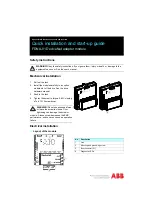
22
FC2005 OPERATING INSTRUCTIONS
Alarm Operation
In case of alarm, the
Alarm
LED flashes, LCD displays alarm conditions and the panel buzzer sounds in a
distinct alarm pattern. Local audible and visual signals and remote alarm signals operate.
When an alarm occurs, proceed according to the established emergency plan. Assure that all personnel are
accounted for and notify the Fire Department to advice of the alarm and/or verify that an automatic signal has
been received at the Fire Department.
Authorized Personnel Only
To acknowledge the alarm:
To acknowledge the alarm, press the
Acknowledge/Buzzer Silence button
. The local buzzer will be
silenced, and the Alarm LED will change from on-flashing to on-steady.
To silence the alarm:
To silence the notification appliances after evacuation, where permitted
,
press the
Silence/Unsilence
(in
US)
or
Signal Silence/Unsilence
(in Canada) button. The silenceable notification appliances will be
silenced. The
Silenced
(in US) or
Signal Silence
(in Canada) LED will change from off to on-stead
y
. Press
the
Silence/Unsilence
(in US)
or
Signal Silence/Unsilence
(in Canada) button again will unsilence the
notification appliances.
Note: Do not reset the panel until the alarm has been cleared.
Warning: Signal Silence inhibit (if set) prevents the alarm from being silenced for a
predetermined time.
To reset panel after alarm:
When the alarm condition is corrected, return the panel to normal standby operation by pressing the
Reset
button.
Trouble Operation
Trouble is indicated by:
Trouble
LED flashes and LCD displays trouble conditions. Panel buzzer sounds in trouble pattern.
To acknowledge the trouble:
Press the
Acknowledge/Buzzer Silence
button
.
The
Trouble
LED turns on-steady and the buzzer turns
off. When the trouble condition has been cleared, you need to reset the panel to restore to a normal
standby condition if panel is not configured as “Trouble
self-restoring
”. When panel is configured as
“Trouble
self-restoring
”, it wi
ll restore automatically to normal standby condition after clearing of trouble
condition.
Warning: devices in trouble condition may not report a fire alarm.
Event Scrolling
Viewing Events on the System:
Events are displayed according to the following rules:
1: Events priority:
Unacknowledged Alarm > Unacknowledged Supervisory > Unacknowledged Trouble > Acknowledged
Alarm > Acknowledged Supervisory > Acknowledged Trouble > Status > Test
2: Within events of the same priority, all events are displayed in the order of occurrence with the latest
displayed the first.
3: S
tatus events are displayed according to the event setting. If it is configured as “No display”, it will not
be listed in Event List.
Fuse Replacement and Battery Maintenance
Battery fuse (F304): 10 A blade type (Littelfuse: 0287010. Bussmann: ATC-10)
City tie fuse (F1-F4): 1.25 A cartridge type (Littelfuse: 02151.25P or Schurter: SPT 0001.2505)
This product requires two 12 V batteries in series, for a combined voltage of 24 V. Replace batteries every 3 to 5
years.
Recommended battery manufacturers:
Power Sonic: PS-12120, PS-12140, PS-12180 Yuasa: NP-12-12
Battery capacity: min. 12 Ah for Canada / 12 - 18 Ah for US Charge current: max. 0.45 A
For service, contact: _______________________Telephone Number:
______________________________
firealarmresources.com
Summary of Contents for FC2005
Page 5: ...firealarmresources com ...
Page 33: ...28 FC2005 Enclosure Mounting Pictures firealarmresources com ...
Page 48: ...43 firealarmresources com ...
Page 58: ...53 This page is left intentionally blank firealarmresources com ...
Page 89: ...84 LE4010 CF Configuration Reference from DSC Installation Manual firealarmresources com ...
Page 90: ...85 TL300 CF Configuration Reference from DSC Installation Manual firealarmresources com ...
















































